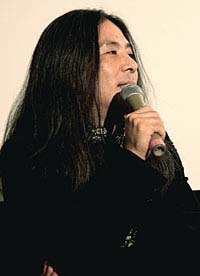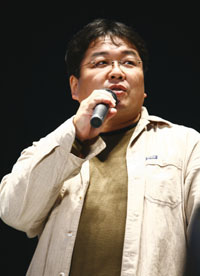Chiaki J. Konaka & Junichi Fujisaku double interview (2)
Ghost Hound and Real Drive are both based on Shirow Masamune's story concepts, but in order to be adapted into full TV series, they obviously needed the work of experienced screenwriters.
In this four-part interview series, we talked with Junichi Fujisaku and Chiaki J. Konaka, series composers for Real Drive and Ghost Hound respectively, and asked about their different approach to Shirow's world, anime storytelling, character development and even voice recording sessions!
 | Chiaki J. Konaka - Born in Tokyo on April 4, 1961. Scriptwriter and novelist. His most famous works include The Big O (series composition and scripwriter, 1999) , Serial Experiments Lain (series composition and scripwriter, 1998), Hellsing (series composition and scripwriter, 2001), RahXhefon (scripwriter, 2002), Texhnolyze (series composition and scripwriter, 2003), and Kino's Journey: The Beautiful World - The Land of Sickness -For You- (screenplay, 2007). Other from animation, he also wrote scripts for the SFX series Ultraman Tiga (directed by his brother Kazuya) and for Takashi Shimizu's acclaimed J-horror movie Marebito (2004), based on his own novel. A renown H.P. Lovercraft estimator, Konaka is also a bass player in the band #3b3 Orchestra. |
 | Junichi Fujisaku - Born on August 6, 1967. Director, scriptwriter, game designer and novelist. He joined Production I.G as Game Production Department Chief Director, but soon became one of Team Oshii's core members, participating to the creation of the theatrical feature Blood: The Last Vampire (2000). The girl in sailor suit fighting monsters with a Japanese sword was in fact Fujisaku's idea. For the Blood franchise he also directed the game version and wrote the novelization. Fujisaku also gave his valuable contribution to the expansion of the Ghost in the Shell world, writing the scripts for many episodes of the Stand Alone Complex series, producing and directing the game version for PS2, and writing three related novels. In 2005 he debuted as a TV series director with Blood+. Besides Real Drive, he wrote the scripts for the FX live action TV series Phone Braver 7, directed by Takashi Miike. |
Part 2: Moving the Characters
Were there any characters that were difficult to render or did not move as you wished?
Konaka: Not that I remember. Ghost Hound is a story about children, but we also had to incorporate adults surrounding them. And I could echo my thoughts in the adults to some extent, so it wasn't stressful at all. (lol) Manga artists often say that the characters start to move on their own. That happens to me too when I construct plots. By the time I reach the half way point, the characters start to move on their own and tell the story for me. In Ghost Hound, it started early in Episode 5.
Fujisaku: As for Real Drive we created our characters from scratch, so I can say that they have always moved as we wished them to. I think they did not drift away from the original concept they were born from. Some of them did change their stance a little with the flow of the story, but these changes were associated with the storyline that aligned with the theme of the drama, so I'd say our initial character setting was well conceived after all.
Are there any tricks to make the characters more attractive?
Konaka: The reason why the Ghost Hound characters are attractive is owing to the character designer Mariko Oka. When Director Nakamura and I team up, we tend to structure our work in a way no one has done before, so at the start, the risk is that some viewers might get confused and wonder what the whole thing is about. So we wanted the audience to love our characters first. We were relieved when we secured Oka-san to join us. As for the character portrayal, I momentarily felt Miyako could be a little more spoony. But I think that girl is like that by nature and I didn't want to stereotype the characters either.
To say it in the extreme, my stance is that the characters compose one element of a story and what the script does is just objectively narrate the characters that depict living people. It might sound like I'm being aloof, but Director Nakamura added more actions when he supervised the storyboards, and Oka-san, who was also the animation supervisor, understood the psychology of each character and rendered that in the facial expressions and actions. I think that's why the viewers feel empathetic toward the characters and are attracted to them.

Fujisaku: In the production of Real Drive, Director Furuhashi is particular about the presence and reality when it comes to the characters. He requested deleting everything, including the movements and the lines that reminded one of typical animation. For him, the storyline could never ignore the character traits either. So in the first episode when the unidentified shockwave hits the island where the main character happened to be, I thought of using a plane crash to add excitement to the scene. He said, "Remove the plane." (lol) Then he left me to ponder again how I could boost the scene. It was hard. Of course, he had a legitimate reason. You have a character you want the viewers to concentrate on and when the plane crashes, that would distract the viewers.
In this way, we took away all the exaggerating factors from the plot and we started from there to work on the characters. Finally, we came up with characters without any visible distinctiveness. I mean they could be anyone around us. So it wasn't until we had the characters designed by Tetsuro Ueyama and finished the dubbing for the first episode that we felt we could see where we were heading. We realized we couldn't get the characters to move around without the dubbed voice. It's the power of the voice actors, I'd say.
Konaka: I totally agree. I didn't want to write the last three episodes until I heard the characters talk, so I let it sit for about two months. (lol) And I resumed my work after voice dubbing started.
Fujisaku: I agree. You can definitely write faster once you have the "voices" in you ears.
Konaka: It's quite difficult with programs that last only one 13-episode set, but with a 26-episode TV show, I would at least hope to start writing after I hear the dubbing voices.
Fujisaku: Exactly. Each dubbing artist has a distinctive way of speaking and takes pauses differently. This obviously affects the number of lines.
(2 - to be continued)
© 2007 Production I.G · Shirow Masamune / GHOST HOUND Production Committee
© Production I.G/Shirow Masamune
© 2008 DNDP, VAP, Production I.G

![WORK LIST[DETAILS]](/contents/works/design/images/left_title.gif)



 terms of use
terms of use